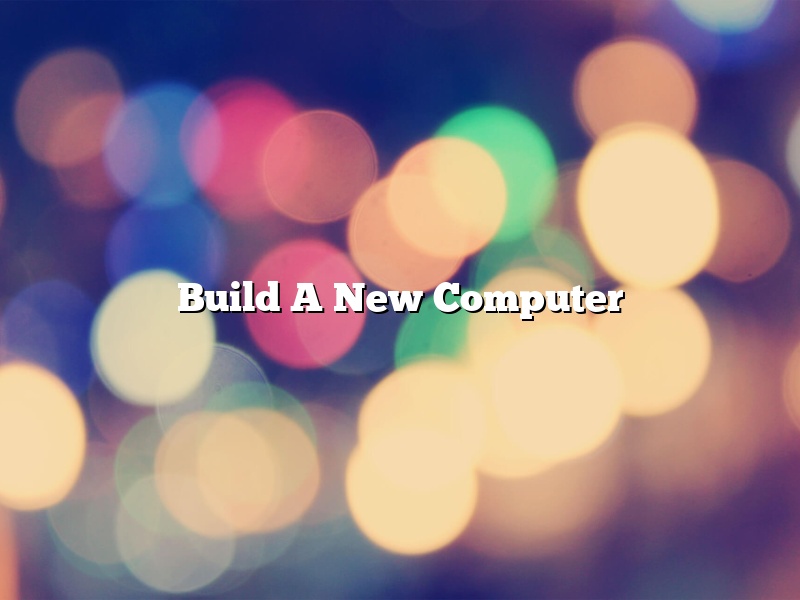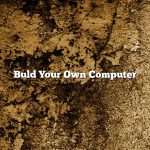There are a lot of reasons to build a new computer. Maybe you need a more powerful machine for gaming or video editing. Or maybe you just want to upgrade your old computer with new hardware.
Whatever the reason, building a computer from scratch can be a fun and rewarding project. It can also be a bit daunting, especially if you’re new to the process.
But don’t worry, we’re here to help. In this article, we’ll walk you through the entire process of building a new computer.
We’ll start by discussing the different components that make up a computer. Then we’ll show you how to choose the right components for your needs. And finally, we’ll guide you through the actual building process.
So let’s get started!
The Components of a Computer
A typical computer consists of four main components:
1. The motherboard
2. The processor or CPU
3. The memory or RAM
4. The storage
We’ll discuss each of these components in more detail below.
The Motherboard
The motherboard is the central component of a computer. It’s a circuit board that contains the connectors for all the other components, as well as the circuitry that allows them to communicate with each other.
motherboards come in a variety of shapes and sizes, but they all have the same basic components. These include the CPU socket, the memory slots, the PCIe slots, and the SATA connectors.
The CPU Socket
The CPU socket is where the processor is connected to the motherboard. Most CPUs today use the LGA 1151 socket, but there are a number of other sockets available as well.
If you’re not sure which socket your processor uses, you can find the specifications for your CPU on the manufacturer’s website.
The Memory Slots
The memory slots are where the memory is connected to the motherboard. Most motherboards have two or four memory slots, and the maximum amount of memory that can be installed depends on the type of memory and the motherboard.
For example, a motherboard that uses DDR4 memory will typically have four memory slots, and each slot can hold up to 16GB of memory.
The PCIe Slots
The PCIe slots are where the graphics card, sound card, and other expansion cards are connected to the motherboard.
PCIe stands for Peripheral Component Interconnect Express, and it’s a type of expansion card that provides a high-speed connection for devices like graphics cards and network cards.
The SATA Connectors
The SATA connectors are used to connect the storage devices to the motherboard. Most motherboards have two or four SATA connectors, and the type of connector depends on the type of storage device.
For example, a 2.5-inch SATA drive uses a SATA connector with a thin profile, while a 3.5-inch SATA drive uses a SATA connector with a wide profile.
The Processor
The processor, or CPU, is the brains of the computer. It’s responsible for processing the instructions of the software and controlling the other components.
Processors come in a variety of shapes and sizes, but they all have the same basic components. These include the cores, the cache, and the clock speed.
The Cores
The cores are the central processing units of the processor. A processor with more cores can process more instructions at once, which makes it faster and more powerful.
The Cache
Contents [hide]
Is it cheaper to build your own computer?
Is it cheaper to build your own computer?
There are many factors to consider when deciding whether or not it is cheaper to build your own computer. The cost of the individual parts, the time it takes to build the computer, and the experience level of the builder are all important considerations.
The cost of the individual parts is one of the biggest factors in determining whether or not it is cheaper to build your own computer. The prices of parts can vary greatly, so it is important to do your research and compare prices before making a purchase.
Building a computer also takes time. It can take several hours to assemble all of the parts and install the necessary software. This can be a deterrent for some people who are not familiar with computer assembly or are short on time.
Finally, experience is a key factor in determining whether or not it is cheaper to build your own computer. If you are familiar with computer hardware and software, it is likely that you will be able to save money by building your own computer. If you are not familiar with the process, it is likely that you will spend more money by building your own computer.
In conclusion, there are many factors to consider when deciding whether or not it is cheaper to build your own computer. The cost of the individual parts, the time it takes to build the computer, and the experience level of the builder are all important considerations.
Is it cheaper to build a PC in 2022?
It is hard to say for certain whether it is cheaper to build a PC in 2022. There are many factors that can influence the cost, such as the type of components used and the market conditions at the time. However, there are some general trends that can be observed.
The cost of PC components has been dropping in recent years, thanks to advancements in technology. This means that it is likely to be cheaper to build a PC in 2022 than it was in previous years. In addition, the price of software and other digital products is also likely to continue to decline, so this will further reduce the overall cost of building a PC.
However, there are some potential risks that could increase the cost of PC ownership in 2022. For example, the price of oil and other raw materials may increase, which could lead to higher prices for PC components. In addition, the value of the dollar may decline relative to other currencies, making PC components more expensive for buyers in other countries.
Overall, it is likely that the cost of building a PC will continue to decline in the coming years, making it a more affordable option for consumers. However, there are some potential risks that could increase the cost of ownership, so it is important to be aware of these factors when making a decision.
Is building a new PC worth it?
Is building a new PC worth it?
This is a question that many people ask, and the answer is not always clear. Building a new PC can be a great way to get the performance you need at a lower price than you would pay for a pre-built model. However, there are some things to consider before making a decision.
One of the biggest benefits of building your own PC is that you can customize it to your own needs. You can choose the components that best suit your budget and your requirements. You can also fine-tune the settings to get the most out of your hardware.
Another advantage of building your own PC is that you can save money. Often, you can get a better deal on components than you would if you purchased a pre-built PC. You can also recycle parts from an old PC, which can help reduce the overall cost.
However, there are some disadvantages to building your own PC. It can be time-consuming to put together a PC from scratch, and it can be difficult to get the right balance of components. If you make a mistake, it can be expensive to fix it.
Overall, whether or not building a new PC is worth it depends on your individual circumstances. If you are comfortable with computers and you have the time to put a PC together, it is likely that you will be able to get a better deal than you would if you purchased a pre-built model.
Where do I start if I want to build my own computer?
So you want to build your own computer? That’s great! It can be a very rewarding experience, and you’ll end up with a machine that’s perfectly tailored to your needs. But where do you start?
The first thing you need to do is decide what kind of computer you want to build. Are you looking for a gaming PC, a workstation, or a simple home computer? Once you’ve decided on a type, you can start looking at specific components.
The most important component of a computer is the central processing unit, or CPU. This is the component that does most of the work, so it’s important to choose a CPU that’s powerful enough for your needs. For most people, a midrange CPU will be more than adequate.
You’ll also need a motherboard, a power supply, RAM, a hard drive, and a case. These are all relatively easy to find, and there are plenty of online guides that can help you choose the right components.
Once you have all the components, it’s time to assemble the computer. This is where the fun really starts! There are plenty of online guides that can walk you through the process, or you can take your computer to a local technician for assembly.
Building your own computer can be a challenging and rewarding experience. If you’re up for the challenge, then go for it! But if you’re not sure where to start, it might be best to leave it to the experts.
Is building a PC hard?
Is building a PC hard?
Building a PC can be a difficult task, but it is not as hard as some people might think. There are a few basic things that you need to know in order to build your own computer, and with a little research, you can figure it out.
The first step is to decide what components you want in your computer. This can be a daunting task, but there are a lot of resources available online to help you make your decision. Once you have decided on the components, you need to make sure that they are compatible with each other.
The next step is to assemble the computer. This can be a bit tricky, but again, there are a lot of resources available to help you. You will need to install the processor, memory, motherboard, and power supply. You will also need to install the graphics card, if you choose to include one.
The last step is to install the operating system. This can be done either by downloading it from the internet or by burning it to a CD. Once the OS is installed, you are ready to go!
So, is building a PC hard? It can be, but with a little research and patience, you can do it.
How much does it cost to build a computer from scratch?
A computer can be a great investment for your home or office. But how much does it cost to build a computer from scratch?
There are a few things to consider when calculating the cost of building your own computer. The price of the components will vary depending on the type of computer you want to build. A desktop computer will be cheaper than a laptop, for example.
The most important factor in the cost of building a computer is the price of the processor. The latest processors can be very expensive, so it’s important to choose one that fits your budget.
Other important components include the motherboard, the graphics card, the RAM, and the hard drive. You can find good deals on these components if you shop around online.
When it comes to assembling the computer, there are a few different ways to do it. If you’re not comfortable assembling the computer yourself, you can always have a friend or family member help you out.
Overall, it’s possible to build a computer for less than $500. But it’s important to do your research and compare prices before buying any components.
How can I get a free computer?
There are a few ways that you can get a free computer. One way is to participate in a computer donation program. Another way is to get a refurbished computer. You can also find free computers through online classifieds or auctions.
One way to get a free computer is to participate in a computer donation program. These programs accept donations of used computers and give them to people who need them. The computers are often distributed through charities or schools.
Another way to get a free computer is to get a refurbished computer. These computers are used computers that have been fixed up and restored to their original condition. They are often sold at a discount price.
You can also find free computers through online classifieds or auctions. Sometimes people give away their old computers when they upgrade to a new one. You can also find used computers for sale at a discount price.




